California ~ and what a good time I had
Near the Beach, Malibu, CA |
By
CORNELIA SECKEL
ART TIMES October 2008
CALIFORNIA. IT HAS been nearly 15 years since I was
in LA, and 30 years since I spent more than a few days in California.
In 1994 I went to LA to visit Joe Price and to see his
collection of Edo-Art at the Los Angeles County Museumand
to see how successful he was in getting his collection on CD, something
that was just being explored by some museums and collectors at that
time. 30 years ago I spent 7 months living and traveling in the SF area
doing — well, that’s another story from a different lifetime.
I have been in contact with two childhood friends, both now living
in LA. We have visited here in NY with the invite always for me to come
for a visit. Leta,
I’ve known since we were infants; Heidi, my friend since we were 10. Once I got past 60 and some other of
my dear friends were gone, the sense of “do it now”, “what are you waiting
for?” got louder and louder.
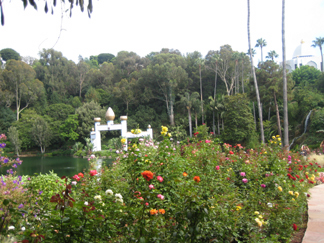 Self Realization Fellowship Lake Shrine on Sunset Blvd. in Pacific Palisades. |
So
off I went during the last part of July and before I began work on the
September issue.
It
is always exciting for me to fly and to see the land from the air. As
we crossed the country, the landscape (when there were no clouds covering
my view) changed from ocean to rolling hills to farmland to more farmland
then to mountains, canyons and desert with fabulous patterns on the
earth’s surface. Before reaching water, cultivated landscapes came into
view and then we were in LA. I rented a car, could hardly believe I
was in LA, and drove to Heidi’s home, not very far from the Bob Hope
Airport (the first commercial airport in CA).
Leta was going on a sailing trip later in the week and so my first
day I headed south over the hills and then west to the coast and had
my first experience with LA freeways and traffic which, being very comfortable
driving in Manhattan, didn’t faze me. Since I made a left instead of
a right when I got off the Freeway at Sunset Blvd., I ended up in West
Hollywood, passing “Maps to Stars’ homes” for sale on numerous corners.
I don’t mind the scenic tour when I’m in a new place and surely enjoyed
the grand homes and landscaping. Leta and I decided on lunch first before
a visit to the Self Realization Fellowship Lake Shrine
on Sunset Blvd. in Pacific Palisades. What gorgeous gardens surround
the lake. Dedicated in 1950 by Paramahansa Yogananda, I can understand why so many thousands of visitors come each year
to enjoy the scenic beauty and serenity of this spiritual sanctuary.
The ten-acre site includes a Court of Religions honoring the five principal religions of
the world; the Mahatma Gandhi World Peace Memorial, where a portion
of Gandhi's ashes is enshrined; and a small museum and gift shop.
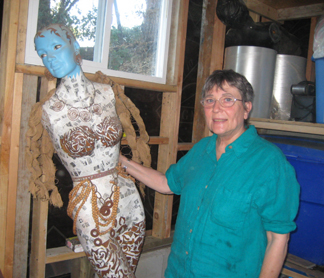 Rebecca Andrews of Topango Canyon and one of her artworks |
We
decided to go up into Topanga Canyon, one of many canyons that
lead from the coast through the Santa Monica Mountains to the
San Fernando Valley. What gorgeous views as we winded up and
deeper into the hills. In the 1920s, Topanga Canyon became a weekend
getaway for Hollywood stars and during the 1960s, Topanga Canyon became
known as a bohemian enclave attracting many artists and musicians. Numerous
music festivals have been organized in the canyon, including the Topanga
Days Festival and Topanga Earth Day. We stopped to visit
Rebecca Andrews, an old friend of Leta’s who lived near the mountain
ridge, and it was clear to me why artists chose to live in these Mountains
— privacy, privacy, and more privacy, along with clear, clean
air and exquisite views. As with many artists she has joined a co-op
and has the opportunity for selling her work and an association of other
artists to mingle with or not. She has been in the canyon for over 35
years, beginning with a tile business to support herself and her family,
as well as her artwork. Now she is able to devote herself to her art,
exploring many different mediums for expression.
We
headed back down the canyon and along the pacific coastline to Leta’s
home and dinner withher husband, Leonard. With old friends one
never runs out of things to talk about and as the evening wore on we
decided to continue our visit and have a “sleep-over.”
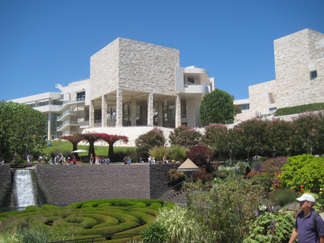 The Getty Center as seen from the Gardens |
I
had expected Heidi to work in the mornings and then be available for
“playtime” in the afternoon and so had brought work to do and several
books to read which I was pleased to abandon. For soon after I arrived
back at Heidi’s from Leta’s home, Heidi returned from work and announced
that she was “Done for the Week” and it was time for doing the things
she doesn’t get a chance to do. Beginning with a pedicure (new for me)
we went from the beach to the Getty Museum, to the beach, to
the Getty Villa, to the beach, to Oxnard and a Salsa
Festival, to explore Laguna and see the Festival of Arts
Pageant of the Masters, and, of course, back to the beach. This
was a work/play excursion, one I was very ready for.
We
headed to the Getty Center where I had made arrangements
for our visit with their very helpful Press office. The Center has just
celebrated their 10th year and is a very large (750 acres)
complex of 5 Exhibition Pavilions, a Research Institute dedicated to
furthering knowledge and advancing understanding of the visual arts,
Auditorium, Sculpture Terrace and extensive Gardens. Not wanting to
miss any of it, we took the suggested route beginning with the gorgeous
gardens, a delightful contrast to the stunning buildings of travertine,
concrete and steel designed by architect Richard Meier.
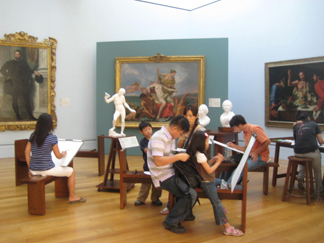 The Sketching Gallery at The Getty Center |
We
went into each of the exhibition pavilions and saw a great variety of
work. Some of the highlights of their collection are: “Arii Matamoe
(The Royal End)” by Paul Gauguin; “Irises” by Vincent Van
Gogh; “Portrait of a Halberdier” by Pontormo; and a copy
of “Portrait of Louis XIV”, by the workshop of Hyacinthe Rigaud.
I was particularly interested to see the exhibit “Maria Sibylla Merian
& Daughters: Women of Art and Science”. I first came across her
work when Raymond wrote about “Drawn and Colored by a Lady” at
Arader Galleries, NYC, in March 2007. The show at The Getty is
an excellent and important tribute to a woman (1647-1717) who not only
documented insects, birds and plants elevating the science of entomology,
but also scientific illustration with her extraordinary drawings. The
exhibit explores her hand-colored publications of flowers and insects,
her success as a specimen-supplier for collectors and naturalists, and
the scientific discoveries that resulted from her journey to Suriname.
More about the exhibit can be found at the Getty website. Also, Raymond
has reviewed the catalogue in our New Art Book Column.
The
Getty has a Family Room, a place for parents and children to draw, build,
and explore art—encouraging a new generation of museum supporters.
As with most museums, there is an extensive list of events each day
of tours, films and education programs. On view through October 26,
2008 is Bernini and the Birth of Baroque Portrait Sculpture.
See the website for additional upcoming and current exhibitions and
programs.
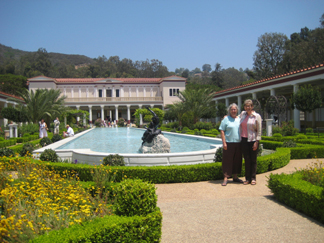 CS & Heidi Robertson in The Getty Villa Gardens |
The next day we headed to Malibu to the Getty Villa modeled after the Villa dei Papiri, a Roman country house in Herculaneum buried by the eruption of Mt. Vesuvius in AD 79. The beautiful gardens have been reconstructed so that they appear much as they would have in an ancient Roman home. Originally, the Getty Ranch was a sixty-four acre piece of property that J. Paul Getty, an American industrialist and founder of the Getty Oil Company, bought in 1943, then opened in 1954 as a small museum. Getty was an avid collector of Roman, Greek, and Etruscan antiquities as well as European art and once the collection outgrew the Ranch in 1974, The Getty Villa was built (now housing over 1,200 works of art from the Getty permanent collection). In 1997 The Villa was closed for renovation and all but the antiquities were moved to the new Getty Center. On the grounds of the Villa are the UCLA/Getty Master's Program on the Conservation of Ethnographic and Archaeological Material, the antiquities curatorial offices, meeting rooms, and the 20,000-volume Research Library. There is also a large amphitheater and auditorium for their extensive programs of concerts, performances, lectures and symposia.
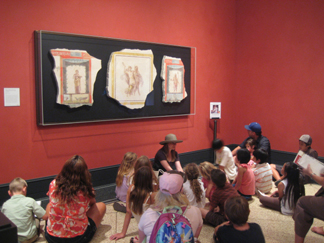 A class visits The Getty Villa and has a lesson with a docent |
Entering
the museum is like going into an archeological dig. We walked down a
ramp and then through a tunnel coming out onto this reconstructed villa.
Exploring the museum is an extensive course of study in the cultures
of the Ancient Mediterranean World. I can only imagine the excitement
of scholars who have come to the Villa to study, or students who are
exposed so comfortably to a possible new area of interest. Brilliantly
designed and laid out with the viewer in mind, we saw jewelry, portraits,
luxury items, sculptures, paintings and reliefs of Gods, Goddesses and
mythological heroes, all presented with clear and concise wall notes.
As
we toured the galleries taking in as much as we could, we found ourselves
talking with other visitors, often asking them to take our picture and
then taking theirs in return. We met people from France, Canada, Italy,
Michigan, Australia, and Hungary.
It
was time for lunch, relaxing on the beach, and a dip into the surprisingly
cold Pacific before returning home.
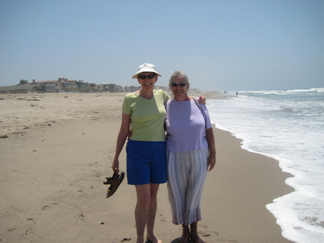 Heidi & CS on the Beach in Oxnard, CA |
Oxnard
is a small town with a multicultural population about 40 miles North
of LA on the Pacific Ocean. Heidi and I were heading there for a Salsa
Festival, one of several festivals that celebrate the rich diversity
of its residents. Well over 150 vendors, including community organizations,
all kinds of food, hand-crafted jewelry, pottery, clothing, garden art,
children’s boutique items, gourmet salsa, and handicrafts from Africa,
Central and South America were among the hundreds of items in the Festival
Marketplace. This 16th annual event also featured excellent
entertainment by Salsa and Latin bands, dancers and musicians. One danced
from booth to booth rather than walk. Another highlight is the salsa
tasting tent where we were able to try hot, sweet, green, red, salsa
from purveyors and restaurants.
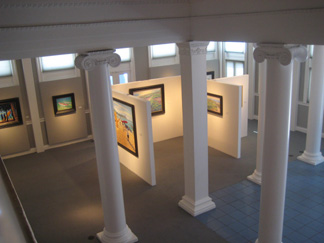 Carnegie Museum, Oxnard, CA |
Andrew
Carnegie donated monies for the construction of 144 Libraries in
California, and between 1891 and 1920 there were 1,678 buildings funded
throughout the US. The Oxnard Library, opened in 1907 and designed
by Franklin P. Burnham, is now, after many different uses, the
Carnegie Art Museum. The collection, begun in 1924, found this
home in 1978 and now includes over 1600 works. It was delightful to
see this small museum that presents temporary exhibitions changing quarterly
and periodically displays selected portions of its permanent collection.
I
came across ArtScene, www.artscenecal.com, a monthly digest
of art in Southern California and found a comprehensive listing of exhibitions
as well as some previews about exhibits. I also saw Local Arts, Guide to the Arts, www.localarts.com, a directory for openings, galleries, museums,
theaters and cultural venues in Orange County, CA. Both are in print
and online and seem to be excellent sources for patrons and participants
of the arts.
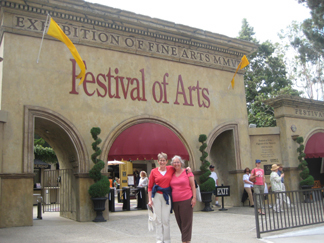 Heidi & CS at the Festival of Arts, Laguna Beach, CA |
I
have been hearing about the Pageant of the Masters for several years,
their PR contacting me each year and I, hoping to get to CA, encouraged
them to keep me informed. Well this was the year and Heidi and I headed
down to Laguna Beach for the Festival of the Arts & Pageant as well
as 2 other art shows (Sawdust and Art A-Fair) that are
on during the Pageant’s season (July — August).
Any
discussion has to start with the Artists and the Laguna Art Association.
I
think I’ve finally gotten it. Why artists choose to paint in a certain
area — it’s the light, the scenery and the living conditions,
but mostly it is the light. And that is why in 1903, Norman St. Claire, a San Francisco artist, abandoned his “cramped fog-laden
studio in Northern California” to become a permanent resident of Laguna
Beach. Other artists came to visit and more and more settled there to
paint in the open air.
In
the summer of 1918, the Laguna Art Museum opened with
the town’s very first Art exhibition. According to the association’s
information, “More than 300 visitors crammed the modest building in
order to view nearly 100 paintings on display in both oil and watercolor,
as well as several pieces of sculpture. There were 25 participating
artists, and by the end of its three-week run nearly 2,000 people had
signed the guest register. That August, the 150-charter member Laguna
Beach Art Association was founded, and the following year the association
became a chapter of the American Federation of Arts. By the end
of the 1920s, the band of Laguna Beach artists were being lauded at
galleries across the nation as their works of California’s rugged coastlines,
verdant hills, vibrant flora and other environmental elements were well
received.”
Pageant workers constructing a "Painting." |
In
1932, in the midst the Great Depression, the idea of a summer art festival
took hold as a fundraising for the association. Apparently the entire
community took part, transforming Laguna Beach into one continuous art
gallery and it was hoped that visitors to the Los Angeles Olympic
Games would travel South to Laguna Beach. The highlight of the event
was the Living Pictures Show, the brainchild of artist and vaudevillian
Lolita Perine, who dressed residents in costumes and seated
them behind makeshift frames. In 1935 the idea was expanded into its
present-day format by local construction worker, realtor and amateur
artist, Roy Ropp. For the next several years the pageant moved
from venue to venue until it found a permanently home in 1941 in Laguna
Canyon.
Not
long after the Laguna Beach Art Association formed, the Laguna Playhouse
was founded in 1920. It began with a group of thespian citizens who
assembled in a living room to establish a theater, initially offering
readings and performances in private homes and storefronts. Laguna Beach
begins to look like Woodstock, NY of the 1920’s – 30’s
with the Maverick and their festivals and concerts, The Playhouse,
Byrdcliffe, and the Woodstock Art Association —
the coming together of creative people to live in a community and to
support one another’s efforts.
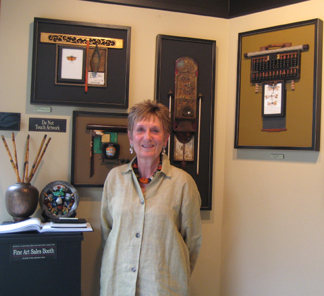 Carolyn Machado and her assemblages at the Festival of Arts, Laguna Beach, CA |
Heidi
and I got to the Festival early enough to be able to tour the fine art
show before the Pageant began and to visit the other Art Shows “down
the road” — the Sawdust & Art-a-Fair which are not juried
and therefore some of the art and fine craft exhibited are more professional
than others. Demonstrations and children’s art areas are always a plus
at these shows.
The
Festival of Arts, held within the pageant grounds, has over 145 artists
that are part of this juried exhibit. Of all the artists, each year
only a third are juried in new, the other two-thirds are invited back,
some returning for as long as their 40th year. I spoke with many of
the artists who were quite pleased to be part of the Fair, many earning
enough in the 2 months to support them the rest of the year. It is a
great idea. The Festival is open for several hours before and after
the Pageant. People can picnic on the grounds while listening to excellent
music that brought a very positive energy to the patrons. A good restaurant,
demonstrations, and a children’s hands-on area as well as other special
events hold the visitors’ attention for a number of hours, during which
time they can explore the work on sale. A ticket to the Pageant allows
the holder to get into the Art Festival as frequently as they like (so
you can go back and buy that piece of art you’ve been thinking about
since you left the grounds).
The
Pageant has a different theme each year; this year it was “All the World’s
a Stage.” I could hardly believe my eyes as the lights went up and a
large framed picture appeared on the stage. The 20 different “living
pictures” and sculptures, all well-known and classical works, were presented
with real people as part of the painting. It was mostly impossible to
tell what was a person and what was the painting. A live orchestra,
some narrative, sophisticated lighting and costuming made this an unforgettable
experience. At one time they showed us how it was done, but I can’t
reconstruct it in my mind. According to the encyclopedia: “Tableau vivant,
French for "living picture," describes a striking group of
suitably costumed actors or artist's models, carefully posed and often
theatrically lit. Throughout the duration of the display, the people
shown do not speak or move. The approach thus marries the art forms
of the stage with those of painting/photography. The phrase and the
practice probably began in medieval liturgical dramas.”
The
Festival of Arts draws 250,000 visitors a year from across the country
and world. The Festival — with its premier attraction, the Pageant
of the Masters, shares it success by awarding millions of dollars over
the years in the form of scholarships to art students and grants to
art and cultural organizations, as well as hosting cultural events on
the grounds throughout the year.
Heidi
& I left amazed, dazed and happy.
The
next day we stopped at the Laguna Art Museum and learned about the organization.
I knew that a show of California Impressionist Paintings was
to be at the Katonah Museum back in New York (reviewed by Raymond
in the September Issue and still online at our website: www.arttimesjournal.com) and thought that
perhaps they had loaned paintings for the exhibit —which they
did not, but were pleased to hear about it. On view in the Museum were
works from their permanent collection (a treat to see) and In the
Land of Retinal Delights, The work of 150 artists. Paintings and
sculptures tricked our eye, turned our heads around and generally intrigued
us. The work was well done and I am sorry that it will not travel. Curated
by Meg Linton and organized by the Laguna Art Museum, the show
explores the idea of the “Juxtapoz Factor” and the possibility of a
new art movement. The Museum has an extensive education and exhibition
program. You can learn more about them and see some of the images from
the current show at
Well, that’s how I spent part of my summer vacation. Thanks to my
friends for making my “working” playtime in California just perfect.
